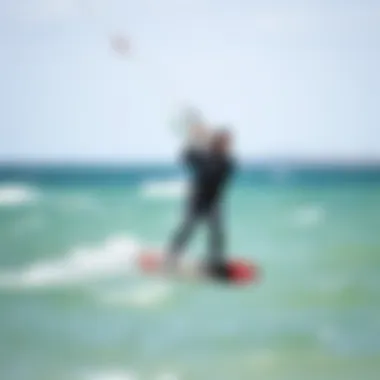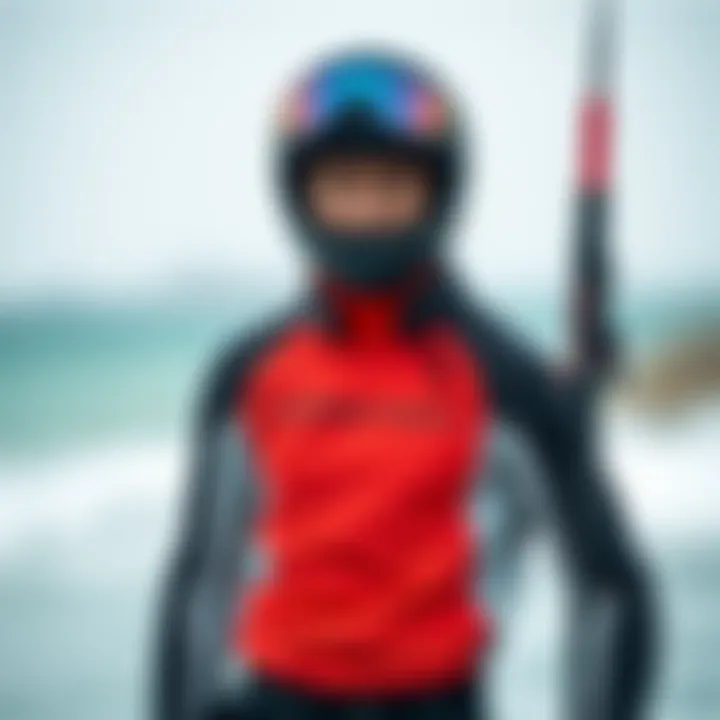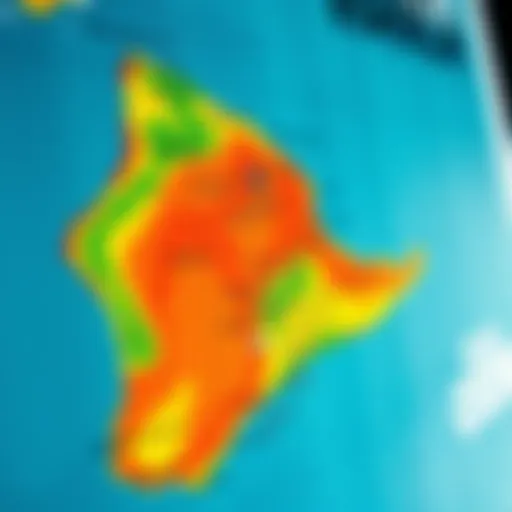Wetsuit vs Drysuit: Essential Guide for Kiteboarders


Intro
Kiteboarding, with its exhilarating blend of surfing and flying, has gained popularity among adventurers on every shore. However, one fundamental aspect remains a puzzle for many enthusiasts: what to wear? A wetsuit or a drysuit? Each of these options boasts unique characteristics that impact comfort, performance, and safety in different conditions. Whether you're just starting out or you're a seasoned kiteboarder, understanding these differences can significantly elevate your riding experience and ensure that you enjoy every moment out on the waves.
In this guide, we will embark on a journey detailing the essential aspects of wetsuits and drysuits, correlating their features with real-world kiteboarding scenarios. From examining the materials that make each suit effective to discussing the designs that enable optimal movement, we will paint a full picture of what kiteboarders can expect. By the end, you will have the insights to make an informed choice tailored to your needs and preferences.
Gear Insights
Latest Gear Reviews
When it comes to gear for kiteboarding, having the right suit can mean the difference between a fantastic day on the water and one filled with discomfort. Reviews are vital to gauge what’s currently favored among kiteboarders. Currently, some top-rated wetsuits include the Xcel Comp X, known for its flexibility and thermal insulation, and the O'Neill Hyperfreak, which is renowned for quick drying and stretchability. For drysuits, the Kokatat Supernova Multi-Sport is frequently praised for its durability and breathability, while the Ocean Rodeo Soul is a popular choice for its versatility in colder waters.
“Your gear is your lifeline, make sure it works for you, not against you.”
Essential Gear for Beginners
For newcomers to the kiteboarding scene, choosing between a wetsuit and drysuit can be daunting. Here's a simple breakdown:
- Wetsuits:
- Drysuits:
- Pros: Great for warmer areas, flexible, affordable.
- Cons: Not suitable for extreme cold, can take longer to dry.
- Pros: Excellent thermal protection in cold water, keeps you dry.
- Cons: Generally pricier, may require additional layering.
Starting out, many find a 3/2mm wetsuit is a solid choice. It offers reasonable insulation without feeling like you're wrestling an octopus. Alternatively, if you find yourself in chilly freshwater lakes or early morning sessions, investing in a good drysuit from day one might not be a bad call.
Techniques and Tips
Advanced Tricks and Techniques
As you progress and start working on tricks, having the right suit that provides freedom of movement can affect your performance. Whether a wet or dry suit, flexibility is key to landing jumps and maneuvers. Remember, practice makes perfect, and being comfortable in your gear allows you to focus on refining your skills. Techniques like the handle pass or the kite loop require precise control, which can be hindered by ill-fitting or restricting suits.
Safety Practices for Kiteboarders
Safety is paramount. Regardless of the suit you choose, always pay attention to the weather conditions and water temperature. Cold water shock is no joke. Wear a buoyancy aid, and ensure your suit fits well to minimize water entry. A snug fit does wonders in keeping warmth trapped by your body while aiding performance, especially when kiteboarding in brisk conditions.
Intro to Wetsuits and Drysuits
Seasoned kiteboarders and newbies alike often face a key decision when gearing up for their adventures: Should they don a wetsuit or a drysuit? This choice is not just a matter of personal preference; it can significantly impact comfort, performance, and safety on the water. Understanding the fundamental differences between these two types of suits is crucial for making an informed decision.
In this segment, we will delve into the importance and purpose of wetsuits and drysuits within the context of kiteboarding. We’ll also provide a succinct overview of each suit type, outlining their distinct characteristics and intended uses.
Purpose and Importance in Kiteboarding
Kiteboarding, exhilarating as it may be, can put you at the mercy of the elements. Water temperatures vary greatly, and exposure to cold can be both uncomfortable and dangerous. This is where wetsuits and drysuits come into play, serving as essential gear to help kiteboarders cope with temperature fluctuations and maintain their performance levels. The main purpose of these suits is to insulate, protect, and enhance the experience on the water, so knowing which one to use can be a game changer.
Wetsuits are generally designed to trap a thin layer of water against the skin, which warms up quickly, whereas drysuits are a barrier against water altogether, keeping the wearer dry while allowing space for thermal layers underneath. These fundamental differences directly tie into the suit's purpose and must be considered in relation to factors such as temperature, duration of activity, and individual preferences.
Overview of Each Suit Type
When one breaks down the world of wetsuits and drysuits, you uncover distinct features tailored to varying conditions and activities.
- Wetsuits: Typically made from neoprene, these suits allow a minor amount of water to enter. This water is then warmed by body heat, creating a sort of natural insulation. They are favored for warmer conditions, where flexibility and full mobility are paramount.
- Drysuits: In contrast, drysuits are constructed with waterproof materials and designed to keep the body dry, even in frigid temperatures. They typically feature a layering system, enabling the wearer to adjust for warmth as needed, making them ideal for colder weather, where maintaining core body heat is essential.
Both wetsuits and drysuits come in various styles, thicknesses, and designs, making them adaptable to different water environments. With a clearer grasp on their purpose and basic characteristics, kiteboarders can approach this decision with a solid understanding, paving the way for a more enjoyable and safe experience on the water.
Understanding Wetsuits


When it comes to kiteboarding, understanding the role of wetsuits is crucial. These suits aren't just an accessory; they play a key role in ensuring the comfort and safety of riders in varying water conditions. Whether you are skimming across warm coastal waves or tackling choppy lakes in cooler climates, a wetsuit has specific benefits that enhance your overall experience. This section dives deep into the components of wetsuits, focusing on material composition, design features, and how they perform in water.
Material Composition
Neoprene: Properties and Benefits
Neoprene is the backbone of wetsuit technology. It is a synthetic rubber that provides excellent insulation. The elasticity of neoprene helps maintain a snug fit while also allowing for freedom of movement, which is vital when you are balancing on your board. The key characteristic of neoprene is its ability to trap a thin layer of water between your skin and the suit. This water heats up and, although it cools off, it doesn’t pull warmth away from you as quickly as the surrounding water does.
A beneficial aspect of neoprene is its durability. It can withstand the wear and tear from saltwater exposure, UV light, and the rigors of active sports. However, it’s worth noting that neoprene does have some drawbacks. Over time, it may lose its elasticity, especially if not cared for properly, leading to a less effective fit.
Thickness Variations for Temperature Control
The thickness of wetsuits varies, typically ranging from 2mm to 7mm and sometimes even thicker for extreme conditions. This variation is significant because it directly relates to thermal insulation. The thicker the suit, the more warmth it provides in cold waters.
Many kiteboarders often prefer a 3/2mm wetsuit for temperate conditions, as it strikes a balance between insulation and flexibility. On the flip side, wearing a suit that’s too thick can restrict movement, making it harder to maneuver your board effectively. Each rider has to weigh their options based on local water temperatures and their own thermal comfort levels.
Design Features
Styles: Full vs. Short
Wetsuits come in different styles, with the most common being full-sleeve and short-sleeve. Full suits provide complete coverage, ideal for colder climates where every bit of warmth counts. On the other hand, short-sleeve suits, or spring suits, are more suited for warmer weather, allowing for better ventilation.
The unique aspect of style selection is personal preference blended with practical need. While a full suit can keep you warmer, it might feel restrictive during a summer session. The challenge is finding what fits your body type and riding style while keeping you comfortable enough to enjoy a full day on the water.
Seal Methodologies: Zippers and Sleeves
The sealing methods used in wetsuits play a crucial role in preventing water from entering the suit. There are primarily two types: zippers and sealed sleeves. Zippered wetsuits provide easier entry but can sometimes let water creep in, especially if they are not sealed at the lower back.
On the other hand, sealed sleeves (which might not have zippers) can create a tighter fit around the arms and legs, minimizing water flushing. The balancing act here involves convenience versus optimal performance. The tight seals can be a little tricky to put on, so finding a model that works for you is paramount.
Performance in Water
Insulation Properties
The concept of insulation in wetsuits directly ties to how well they can retain body heat in cold water. A wetsuit’s ability to insulate comes from its material and thickness. The right wetsuit will manage heat effectively, allowing you to focus on enjoying your kiteboarding rather than shivering.
The downside is that while good insulation is a win, very insulated suits can lead to overheating in warmer waters. Balancing the right type of insulation for the given conditions is essential for performance.
Flexibility and Range of Movement
Having a wetsuit that offers flexibility can be the difference between executing a trick and taking a tumble. Suits designed with articulated joints and high-stretch neoprene allow better mobility, which is vital for kiteboarding maneuvers.
The trade-off comes again with thickness; while a thicker suit offers more warmth, it may limit your flexibility. Thus, understanding your body and how you move on the board will determine what kind of wetsuit will serve you best.
Exploring Drysuits
Understanding drysuits is essential for any kiteboarding enthusiast, particularly those seeking to extend their time on the water during colder conditions. Unlike wetsuits, which provide thermal insulation through water retention, drysuits are designed to keep water entirely out, making them a favored choice for colder climates. This section will delve into key elements such as materials, design features, and the operational advantages that a drysuit can offer.
Material and Construction
Waterproof Fabrics Explained
Waterproof fabrics are the cornerstone of any effective drysuit. These materials are engineered to create a barrier against water, allowing the wearer to stay dry even in frigid conditions. Key characteristics of waterproof fabrics, such as Gore-Tex, include their durability and excellent breathability. While thoroughly waterproof, they also allow sweat vapor to escape, which is crucial for maintaining comfort during active sports like kiteboarding.
The unique feature of these fabrics is their multi-layer construction, which often includes a waterproof membrane sandwiched between a protective outer layer and a comfortable inner layer. The undeniable advantage of this approach is enhanced thermal comfort, as it balances both insulation and moisture management, crucial for those long sessions on the water. However, they can be pricier than traditional materials, requiring careful consideration on your budget.
Layering Systems for Insulation
Layering is another integral element of the drysuit construction which maximizes insulation. A common practice is pairing the drysuit with thermal undergarments designed to trap heat while still allowing moisture to escape. This not only helps keep the body warm but also adds flexibility when it comes to adjusting for changing weather conditions.


Key characteristics of these layering systems include their diversity; they range from fleece options to more advanced synthetic materials that provide excellent thermal efficiency without bulk. The unique feature here is that each user can tailor their layering for the specific temperature and activity level of their kiteboarding session. One thing to note is that layering can sometimes compromise mobility if not done correctly, so choosing the right undergarments remains a vital consideration.
Key Design Attributes
Sealing Methods: Gaskets and Zippers
The effectiveness of a drysuit often hinges on its sealing methods. Gaskets, usually found at the neck, wrists, and ankles, provide a watertight seal that keeps the inside totally dry. Coupled with high-quality zippers, they define how well the suit performs.
The main characteristic of gaskets is their snug fit, preventing water ingress during falls or splashes. Many modern drysuits utilize latex or neoprene gaskets that can conform to the body shape. The unique advantage here is they offer a highly secure seal without excessive bulk, however, they may require periodic replacement due to wear and tear.
Breatheability Considerations
Breathability is a critical aspect of drysuits, directly impacting comfort and performance. This refers to the suit's ability to release moisture generated by the body as you exert energy. Well-made drysuits often incorporate breathable fabrics or ventilation systems that help manage moisture.
The main characteristic of breathable drysuits is their capacity to prevent overheating during intense kiteboarding sessions, thus enhancing overall comfort. A unique feature of newer models is their adjustable vents that permit airflow when needed, while still providing a waterproof barrier. A downside could be that overly breathable options may sacrifice some level of waterproof integrity, making it vital to find a balance that aligns with your activity level and weather conditions.
Operational Suitability in Water
Thermal Regulation in Cold Weather
Thermal regulation in colder water is perhaps the most significant benefit of using a drysuit. Drysuits allow you to maintain your core temperature even when the outside air and water are chillingly low. By utilizing insulation layers beneath the suit, riders can adjust their warmth by choosing different thicknesses according to conditions.
The main characteristic here is that drysuits can provide a controlled environment, preventing excessive heat loss that can come with long exposure to cold water. The unique feature is that since users can layer as they see fit, it becomes an effective solution whether you're riding in mild spring weather or amidst the ice melt of late winter. A downside does exist, though; it can be challenging to manage sweat during active sessions unless ventilation means are implemented.
Mobility Concerns and Solutions
Concern regarding mobility isn't unfounded when considering drysuits. While the goal is to offer complete protection, overly tight or rigid designs can limit movement, hindering performance. A well-designed drysuit, however, strikes a balance between robustness and flexibility, allowing for a full range of motion while still protecting against the elements.
One key characteristic of top-tier suits is their use of articulated joints and stretch panels in the driving areas of the suit, like the knees and shoulders. The unique benefit here is that improvements in design minimize mobility compromises, offering a better overall experience while kiteboarding. As a caution, it's crucial to try on various options to find the right fit, ensuring comfort doesn’t come at the expense of unrestricted movement.
Comparative Analysis: Wetsuit vs. Drysuit
The selection between a wetsuit and a drysuit is not just a matter of preference; it significantly impacts the kiteboarding experience. Understanding the nuanced differences between these two options will empower enthusiasts to make informed decisions that best suit their individual needs. Factors such as water conditions, temperature, and duration of use all come into play.
Conditions for Use
When it comes to conditions, wetsuits and drysuits serve distinct purposes that can make or break a session on the water. Wetsuits are ideal in warmer waters but can be used in cooler temperatures as long as they are thick enough. They trap a thin layer of water between the suit and the skin, which is then warmed by body heat. On the flip side, drysuits are designed for colder conditions. With waterproof seals and insulated layers, they keep you dry and warm, even in frigid waters. Kiteboarders planning a long day out in the cold should consider a drysuit for its superior thermal properties.
Cost Considerations
Pricing can vary considerably between wetsuits and drysuits, which is an important factor for budget-conscious kiteboarders. A decent wetsuit can range from $100 to $500 or more, depending on the materials and features. On the other hand, drysuits tend to come with a heftier price tag, often starting around $300 and going much higher, easily reaching $1,500 for high-end models. While it might be tempting to opt for a cheaper wetsuit, one should consider the lifespan and functionality—investing in a reliable drysuit might save money in the long run for those who spend more time in colder waters.
Pros and Cons of Each Suit
- Wetsuit Advantages and Limitations
Wetsuits have their own set of strengths. One significant advantage is their flexibility, which allows for greater range of movement—essential for performing tricks or maneuvers on the water. They can be surprisingly warm when properly fitted, but in chilly conditions, they may leave you feeling a bit cold after prolonged exposure.On the downside, wetsuits don’t keep you completely dry. If your session stretches over many hours, that trapped water can get chilly, especially as the temperature drops. Additionally, they may limit airflow and can feel restrictive if they are not the right fit. - Drysuit Strengths and Weaknesses
Drysuits shine in colder climates, offering an unparalleled level of insulation. The ability to layer clothing beneath a drysuit allows kiteboarders to tailor their temperature control based on personal preference and conditions. Furthermore, the drysuit ultimately keeps you bone dry, making it easier to muster up the courage for a long day of kiteboarding in frigid water.However, with advantages come disadvantages. Drysuits can feel bulkier than wetsuits, potentially restricting movement. The complexity of zippers and gaskets can be overwhelming for newcomers. Additionally, they require a bit more maintenance to keep gaskets in good shape and prevent leaks.
"Making the right choice between a wetsuit and a drysuit isn’t just about comfort; it directly influences performance in the water."
In summary, each suit type has its niche in kiteboarding. Your choice should reflect your local conditions, personal comfort, and level of commitment to the sport. Both wetsuits and drysuits have something unique to offer, making it crucial to weigh these pros and cons carefully.
Choosing the Right Suit for Kiteboarding
Selecting the appropriate suit for kiteboarding isn't just a matter of personal preference or aesthetic value. It can heavily influence your performance on the water, your comfort during sessions, and even your overall safety. The right choice can mean the difference between an exhilarating day riding the waves and an uncomfortable one that could lead to early withdrawals from your adventure. Whether you lean towards wetsuits or drysuits, understanding what suits your individual needs is vital.
Assessing Personal Needs
Local Water Conditions
Local water conditions form the backbone of your decision-making. We all know that waters can vary drastically; a warm lagoon feels entirely different from a chilly ocean crash zone. The temperature of your water can significantly influence your comfort. For instance, if you're kiting in tropical climes where waters are generally warm, a thinner wetsuit or even a shorty might suffice. In contrast, colder environments might demand a good drysuit or a thicker wetsuit for adequate insulation against the biting chill.


Another prime aspect of local conditions is the currents and tides. Areas with strong tidal flows can affect your balance and repositioning in the water. If you're in such a spot, you may benefit more from a suit that offers better mobility and heat retention. Ultimately, recognizing your local water will help you select the best suit that minimizes discomfort and maximizes enjoyment.
Duration of Use
How long you’re planning to hit the water matters a lot, as well. Suppose you're a weekend warrior taking short sessions. In that case, wearing a wetsuit that offers flexibility might be the right fit. Alternatively, if you're aiming for long days out where staying warm is paramount, a drysuit might be your best bet, given its excellent thermal regulation capabilities.
Consider that wearing a suit for hours on end can lead to accumulated water inside, especially if it’s not properly secured. Wetsuits tend to feel heavy and constricting after prolonged usage, which can detract from the freedom that kiteboarding is all about. Choosing the right suit thus involves balancing your immediate comfort with the suitability for extended sessions.
Trial and Experience
Renting Functional Options
Before diving into a purchase, there's wisdom in trying before you buy. Renting functional options gives you the opportunity to feel out different styles and materials without committing hard-earned cash upfront. Rental shops often have a range of sizes and styles, making it a prime chance to assess the best fit for your body type and riding style.
A unique advantage of renting is the ability to adapt quickly to differing conditions. Maybe today’s kiteboarding session is in a warmer bay and tomorrow's adventure takes you to frigid coastal waters. By renting, not only can you sample different suits, you also avoid the headache of having to own multiple suits yourself.
Feedback from Other Enthusiasts
Gleaning feedback from more experienced kiteboarding enthusiasts can be invaluable. Peer insights often expose you to aspects you didn't consider. Each kiter's journey is unique, and their successful experiences can shed light on what works best for certain conditions.
Consider participating in online forums or social media groups dedicated to kiteboarding. Websites like Reddit can be a goldmine for shared experience. Asking others about the suits they use can lead you to surprise discoveries, and maybe even lead to test opportunities.
"The right suit speaks the language of comfort and performance, turning potential struggles into seamless rides."
In essence, making an informed decision about the suit you choose for kiteboarding can enhance your sessions significantly. By considering local water conditions, duration of use, testing via rentals, and gathering insights from fellow enthusiasts, you'll be well-equipped to find the right fit for your kiteboarding adventures.
Maintenance and Care for Suits
When it comes to gear like wetsuits and drysuits, taking proper care of them is just as crucial as selecting the right one. The longevity and performance of these suits hinge significantly on maintenance routines. Kiteboarding involves exposure to saltwater, sand, and various environmental factors, all of which can take a toll on your equipment if not addressed.
Routine care can not only extend the life of your suit but also optimize its functionality on the water. An ill-maintained suit can lead to issues like compromised insulation, reduced flexibility, or even pre-mature wear and tear. By implementing the right cleaning and storage practices, you'll ensure that your investment in these suits pays off in the long run.
Cleaning Protocols
Proper cleaning is fundamental to keeping your wetsuit or drysuit in tip-top shape. After each kiteboarding session, it's essential to rinse your suit in fresh water. This simple action helps remove salt, sand, and grime that can degrade the material over time. Consider the following points for effective cleaning:
- Immediate Rinse: After surfing, don’t let the salty water sit too long. As soon as you can, rinse it out in fresh water to prevent damage.
- Gentle Soaping: Use a mild soap specifically designed for wetsuits. Regular detergents may harm the fabric and seals.
- Avoid Soaking: Instead of soaking for long periods, just a quick rinse followed by a light wash is sufficient.
- No Heat! Never use hot water or tumble dryers. The heat can melt or warp the delicate material.
The key is to be gentle. Overscrubbing or using harsh chemicals can lead to a breakdown in the material, and that might not show up until you need that insulation out on a chilly day.
Storage Recommendations
Once your cleaning routine is complete, focus turns to how you store your wetsuit or drysuit. Improper storage can lead to creasing, which can rupture seams or adversely affect insulation. Here are best practices to keep in mind:
- Hang or Lay Flat: If possible, hang your suit using a wide hanger to prevent any stretching in the shoulders. If you have the space, laying it flat is also a good method to prevent creases.
- Avoid Direct Sunlight: Store suits in a cool, dry place. Sunlight can fade colors and break down the materials over time.
- Keep Away from Heavy Objects: Try to keep your suit away from anything heavy that could crush it in the process of storage. You want your suit to keep its shape, after all.
- Use Ziploc Bags for Small Accessories: Items like gloves or booties can be stored in resealable bags to keep them organized and less susceptible to damage.
Taking a few moments to follow these maintenance practices can save you from larger headaches and expenses down the line. Not only do you preserve the integrity of your equipment, but you also ensure a more enjoyable and comfortable experience when you hit those waves.
"An ounce of prevention is worth a pound of cure." By investing time in maintaining your wetsuit or drysuit, you're laying the groundwork for many successful kiteboarding sessions ahead.
Ending
In the end, when it comes down to choosing between a wetsuit and a drysuit, it’s really about understanding your own needs and the specific conditions you plan to face while kiteboarding. Each suit serves distinct functions and comes with its own set of advantages and disadvantages, making the decision process a critical part of enhancing your kiteboarding experience.
Final Thoughts on Suit Selection
Selecting the right suit is not just about brand popularity or trends; it's about what keeps you safe and comfortable in the water. Consider factors such as water temperature, duration of use, and personal comfort. For instance, on those chilly days when the water feels like ice, a drysuit may serve you best, keeping every droplet outside while you enjoy your ride. On the other hand, if you are catching waves in warmer waters, a wetsuit could offer the flexibility and comfort you need without overheating your body.
Also, remember that trying on different suits, if possible, can change the game. Fit isn’t just comfort; it directly impacts your performance. If it pinches or flaps, you’re in for a tough time. Take your time—experiment, and only invest in what feels right for your unique setup.
Encouragement to Explore Options
Don’t hesitate to explore and learn! Kiteboarding is all about adventure, and your suit is just part of that journey. Check out reviews, join forums, or talk to fellow kiteboarders about their experiences with both wetsuits and drysuits. Each user brings different perspectives and preferences.
Moreover, there are multiple brands and styles out there; finding what resonates with you can be quite enjoyable. Websites like Reddit or Facebook have groups where enthusiasts discuss their favorite gear. Look for local shops where you can see the suits firsthand, test them out, and make a decision informed by your experience. Whether you’re a newbie or a seasoned professional, there’s always something new to learn within the kiteboarding community.















